#the original folk tales of grimm brothers
Text
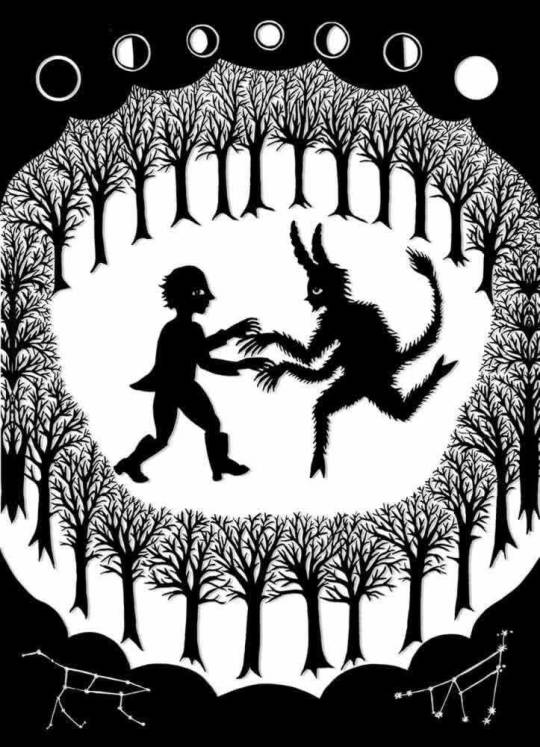
The Original Folk and Fairy Tales of the Brothers Grimm illustrated by Andrea Dezso
736 notes
·
View notes
Text

🍎Snow White (or The Beautiful Daughter)
I started this piece back in 2022 but it sat in my WIP folder for several months. This made the recent "Snow White is WHITE! It's in the name!" comments going around online due to Disney's new live action film particularly funny to me because...umm...no?
Snow White was a name the Grimm Brothers titled their version of a story that can be found throughout history; generally dubbed a "Beautiful Daughter" tale. These stories always featured a beautiful step daughter in danger of being killed by a wicked step mother, though the name and features of the heroine changed depending on where the story was being told. Many other aspects of the story would remain quite similar, even if the two versions were from vastly different parts of the world.
For example in many European versions of the story the wicked stepmother tries to kill the heroine by offering to comb her hair with a comb covered in poison. In some African versions the stepmother offers to comb the heroine's hair but rather than attacking with the comb itself, jammed a nail into her head while her back was turned. (which seems way more brutal to me!?)
Anyways, after reading a collection of "Snow White" style stories from African countries I really wanted to make an artwork for my Fairy Tale calendar that featured a black Snow White. I never could have guessed that a couple of months later my random readings of diverse Snow White stories would be so relevant! 😅
#digital art#digital illustration#small artist#originalartwork#original content#fairy tale art#fairytales#fairy tale#snow white#grimm brothers#disney#folk lore
34 notes
·
View notes
Text
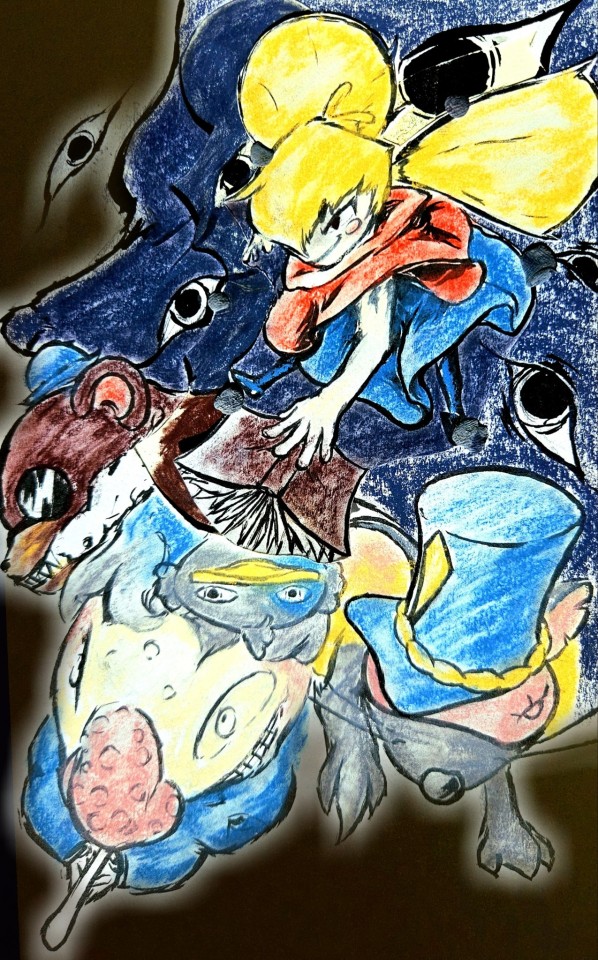
Artfight Attack Roundup #9: Revenge on friend and Xitter user GravityMonkey1's character, Morgan Cloverwood aka The Little Red Riding Hood, accompanied by her motley crew of Grimm-O-War fairytale summons.
Originally submitted edit after the break.

#they took me up on my Design a Pokemon cultist prompt that absolutely slapped#their art is killer go give them a follow#pastel art#nupastel#artfight#artfight 2023#falgaiart#other folks ocs#original character#brothers grimm#fairy tales#traditional art#recent falgaiart
4 notes
·
View notes
Text
Polling based off what were the "big" ones for kids growing up in the US, based off my very limited anecdotal observations. Asian, Native American, and African mythology and folk traditions are so so fascinating to me and it's a crying shame they're not more thoroughly covered by our shoddy education system. I'll probably make a follow up poll depending on how this one turns out. Tell me in the comments/tags!
Bonus: if you learned about a mythology through the original myths or a more niche option, what's your opinion on Riordan, Marvel, and other major adaptations? Do you get to be pretentious about it or do you vibe with them?
366 notes
·
View notes
Text
Why are there Infinity Loops or Möbius Strips in Good Omens?
The infinity loop, it's the idea of something that is unlimited and endless, you know...

In this post, I'm going to explore some of the symbols in the show that I think relate to this concept of eternity. For example, have you noticed that the infinity loop shows up amongst the symbols at the start of Season 1? While God's narrates about her "ineffable game" of her own devising, here it is on screen:

Why do we see so many infinity symbols here? Where else can we see this same symbol?
Read on for the places I've spotted it in both S1, S2 and the book. I’m hoping you’ll let me know if I missed any, and what you think it all means!
Eternity in Good Omens
In the book, when Crowley is explaining the concept of eternity to Aziraphale, he uses the idea of a bird which flies every thousand years to the same mountain to sharpen it's beak. Here's the conversation, with Aziraphale's interruptions edited out (pg. 55 - 56 in my hardcopy):
“Just you think about it," said Crowley relentlessly. "You know what eternity is? You know what eternity is? I mean, d'you know what eternity is? There's this big mountain, see, a mile high, at the end of the universe, and once every thousand years there's this little bird—”
“Okay. And every thousand years this bird flies—"
"flies all the way to this mountain and sharpens its beak—”
“Sharpen its beak on the mountain," said Crowley. "And then it flies back—”
“And after a thousand years it goes and does it all again," said Crowley quickly.”
This story originally came from a folk tale called the Shepherd Boy. It's very short and you can read the Brother's Grimm version here. (Update: The Annotated Pratchett also thinks this may be a reference to James Joyce's Portrait of the Artist as a Young Man).
If we take Crowley at his word, then eternity in Good Omens is represented by repeating the same thing over again, whether that's flying forever to the same mountain, or having to watch the Sound of Music "over and over and over and over and over and over and over" into infinity.
The Infinity Loop
The common symbol for infinity, ∞, was invented by the English mathematician John Wallis in 1655. Being an extremely popular symbol, it shows up in a lot of places, including the Rider-Waite Tarot deck. Several other uses are detailed on the wikipedia page.
So, where does it appear in Good Omens? In addition to God's monologue, we also see it during the S1 baby swap sequence as part of the Satanic nun's costumes. Here it is on the upside-down watches they wear:

Here it is again on Newt's belt buckle in S1:
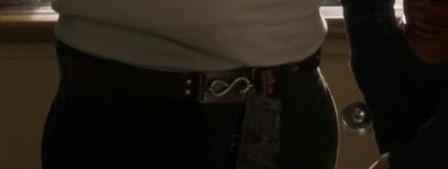
Here's another possible infinity symbol on Newt's computer screen, when he's working at United Holdings:

Outside of the show, it also appears on the merch released post-S2 (though a little bit disguised in the form of the snake wrapped around them). Included is the tagline of "The end was just the start".

There are also two references to infinity in the book. Here's the first very near the start (pg. 14 of my 2015 hardback edition):
“He [God] plays an ineffable game of His own devising, which might be compared, from the perspective of any of the other players, [ie., everybody.] to being involved in an obscure and complex version of poker in a pitch-dark room, with blank cards, for infinite stakes, with a Dealer who won't tell you the rules, and who smiles all the time.”
And here's the other, closer to the end, at the airfield (pg. 363 of my edition):
“Adam glanced up. In one sense there was just clear air overhead. In another, stretching off to infinity, were the hosts of Heaven and Hell, wingtip to wingtip. If you looked really closely, and had been specially trained, you could tell the difference.”
So, Good Omens makes a few references to infinity, which I find interesting in itself. But wait, there's more!
The Ouroboros
There is another symbol which also appears in Good Omens and also suggests a form of repetition - the ouroboros. The ouroboros is an ancient symbol depicting a serpent or dragon eating its own tail and depicts an eternal cycle of renewal - an end which comes back to the start again. I recommend taking a look at the whole wikipedia page, which is quite fascinating:
Now, this would be a rather abstract representation, but I think this appears on the wall of Nina's cafe. Unfortunately, in my image Terry's name has been cut off, but it does say Terry and Neil within those segments of the loop:

So we have the infinity symbol, the ouroboros... anything else? Well, yes, there is a third symbol for us to ponder over.
The Mobius Strip
Closely related to the idea of the infinity symbol is that of the mobius strip. To oversimplify things, the mobius strip is a object which is a continuous surface in a loop. At first glance, it appears to have two sides, but these are indeed all part of the same side (maybe we should call this "our side"?). As shown in the below gif, an object traversing the surface of the strip can repeat in a continuous loop.

Where does the mobius strip appear in Good Omens? Well, it appears in the book. Here it is being used to refer to Anathema's broken bike wheel (pg. 92 in my 2015 hardback edition):
“Behind the Bentley a bicycle lay in the road, its front wheel bent into a creditable Mobius shape, its back wheel clicking ominously to a standstill.”
And again, describing the discussions of the Them, while Adam is coming into his powers (pg. 229 in my hardback):
“Serve everyone right if all the nucular bombs went off and it all started again, only prop'ly organized," said Adam. "Sometimes I think that's what I'd like to happen. An' then we could sort everythin' out."
The thunder growled again. Pepper shivered. This wasn't the normal Them mobius bickering, which passed many a slow hour. There was a look in Adam's eye that his friend couldn't quite fathom—not devilment, because that was more or less there all the time, but a sort of blank grayness that was far worse.”
Not only does the word "mobius" appear twice in the book, but Neil has continued to be interested in such ideas, releasing the song Mobius Strip in April 2023 (as brought to my attention by @embracing-the-ineffable). The song is a meditation on the nature of time, magic and how things tend to repeat. In the song, the grandfather shows the boy a trick to creating a mobius strip using paper, tape and some scissors. Here's how the song concludes:
"I'm... Somewhere on the strip
We all are, walking the sign of infinity into the darkness
And I'm looking for signs of a life, in a memory
Reflected in the mirror
I'm a mobius strip
We all are
We only ever see one face
It's the twist that brings you back where you started"
If you're unfamiliar with the idea of creating a paper-based mobius strip, here's a video on how it works:
youtube
Is the loop Aziraphale and Crowley?
To form a mobius strip, you need to cut the paper first, flip it, and then join the ends back together.
To me, this reminds me a lot of the S2 opening sequence, when we see the bridge disconnect, separating Aziraphale and Crowley on either side, only to then reconnect at another place.
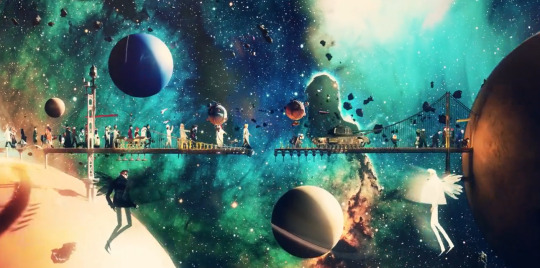

Does this mean the bridge, and perhaps the loop, represents our ineffable duo? This merch sure seems to suggest so...
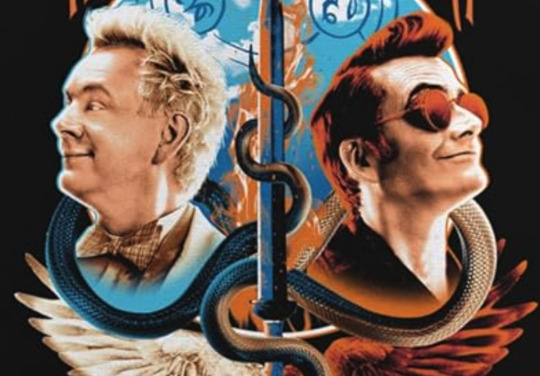
That could be one interpretation of this sequence, though I'm sure there are others. What do you think? Does the loop say anything about Crowley and Aziraphale's relationship to one another?
Put it all together and...
In summary, we have at least three different symbols signifying some sort of repetition in Good Omens - the infinity loop, ouroboros and mobius strip. So, what might they mean? Why do you think it's been included, and so often? Even more importantly, have I missed any? There's endless details to be mined from this show, so I wouldn't be surprised if there are more.
I have a few theories, but nothing concrete yet, so I'm really interested in hearing everyone's ideas!
#good omens meta#ineffable mystery#good omens clues#good omens analysis#go meta#good omens s2#good omens s1#good omens season 2#good omens season 1#good omens#good omens details#infinity symbol#infinity loop#mobius strip#newton pulsifer#ineffable husbands#ouroboros#Youtube
121 notes
·
View notes
Note
I was thinking, what if while at Y/N's house the boys end up finding the Grimm Brothers/Original stories they're based off. Like the original Snow White or Little Mermaid by Hans Christian Anderson. And Y/N admitting that they were more familiar with those versions than the Disney version was expecting to be skinned alive when they first arrived in Twisted Wonderland
I’m so so fucking pumped for this ask because I’m a huge NERD and I know the original stories so well. Fairytales and folk tales and mythology are one of my special interests you cut straight to my heart thank you anon. Also you didn’t specify what universe this is so I’m putting it in the our world au and if you want me to do the other characters I will GLADLY do them I adore these. ++ I will probably do Idia reacting to Greek myths sometime soon but my brain is honestly kinda mush and narrowing down just one myth is a little hard but I’ll get back to it
This Isn’t How Our Story Ends
Characters: Riddle, Trey, Leona, Ruggie, Azul, Jade, Floyd, Kalim, Jamil, Vil, Rook, Idia, Malleus, Lilia
Warning: the original tales of each story are dark. As such, there will be mentions of mature topics such as death, poisoning, drowning, murder, insanity, and more. Read at your own discretion.
Cw// spoilers for chapters 1-5, swearing, dark topics and themes.
“What’s this?” He had asked innocently, holding up the book in question.
“Huh? Oh, that’s…” Yuu thought of how to explain this, “Well, it’s a story. Kinda. Um…well…”

Hamlet
It’s fairly well known that the story of Hamlet is the origin of The Lion King (although interestingly enough it seems there’s a real life historical parallel with the story of Sundiata Keita) thus Leona and Ruggie’s interests in this particular story may wain. Shakespeare is dreadfully dry at times and best performed live, which means…Movie night! For this particular iteration I would recommend watching a live taping rather than a film adaptation because otherwise you just miss out on like, half the important shit. Also if you haven’t read or seen hamlet there’s a lovely novelized adaptation that actually adds MORE content and makes it very fun
Leona sat back as he watched the actors take the final bow. Ruggie was nervously sitting beside him, shifting from side to side like he couldn’t quite get comfortable.
“They all died?”
“Yep.” Yuu responded dispassionately.
“And the uncle…” Leona started, eyes looking over everything in the room except Yuu and Ruggie, “In the, uh…”
“That’s the king of beasts, in your world.” They said, “It’s…yeah.”
“He killed for the throne?” Ruggie asked, somewhat surprised.
“I mean, Leona tried to kill Malleus for a game, I’m not sure why you’re surprised.”
“I wasn’t gonna kill ‘im.” Leona grumbled, “Just put him out of commission for a while. Not tryina start a war or anything…”
“Okay, you attempted to maybe kill him.”
“That’s not- whatever.” He sighed, “So, I’m the uncle. Is Ruggie the guy who got stabbed? The…sheriff? Or whatever?”
“I guess in this analogy, yes.”
“Gross.” Ruggie wrinkled his nose, “I’d rather be the girl.”
“Ophelia?”
“Is that the one that drowned?”
“Yes?” Yuu worried.
“Yeah, her. Anything to get away from this analogy.”
Leona snickered and ruffled Ruggie’s hair, earning him a harsh smack to the forearm which he ignored.
“Did the king of beasts have his own sheriff? According to your world?”
“Uh, he had the hyenas. And Zazu, I guess, but none were exactly loyal.”
“Did the king of beasts kill his nephew?” Ruggie blurted out.
“Nah, but he tried. Instead, the nephew killed him.”
Leona wrinkled his nose, joking in a deadpan tone, “Guess it’s time to off the little furball back home.” When neither Yuu nor Ruggie laughed, he frowned, “You know I’m joking, right? I wouldn’t kill my nephew.”
“You tried to kill me.” Ruggie said.
“And me.” Yuu agreed.
“That was ONE TIME-“

The Little Mermaid
Fun facts the little mermaid was written by Hans Christian Andersen and depending on the historical lens you like to apply was maybe gay. Also, the sea witch doesn’t have a name and doesn’t have eels which means Azul and the twins will be sorely disappointed. Anyway the original story is an angst fest because Hans was an emo at his core and the princess dies at the end
Azul stared at the pages of the book as he slowly closed it. He adjusted his glasses, looking to the twins as he finished. The two looked sick, wearing grim expressions. Floyd stared to his shoes while Jade looked to Azul.
The Octavinelle dorm leader cleared his throat, then took a sip of his water. After a few moments, he turned to Yuu.
“This was a deeply unpleasant experience.”
Yuu snorted a little and nodded, “Fair enough. It’s honestly what I thought was gonna happen to me when I made that deal with you.”
All three of them looked shocked and stared at Yuu like they’d grown three heads.
“Yuu…” Jade started tentatively.
“You know turning to sea foam is like, the worst punishment you can get in the Coral Sea, right?” Floyd cut in, eyes blunt.
Yuu’s expression dropped. They turned and checked each of the trio to see if they were joking and…no, no that’s real.
“What?”
Jade stared at them in deep contemplation, before piping up, “I suppose you wouldn’t know that, it isn’t something the kingdom advertises, per say…”
“But it’s something almost every merman knows.” Azul finished, “This version of the sea witch is…cruel. Unusually so, to sentence a mermaid to that hell.”
“And a princess, nonetheless.” Jade agreed, “Incredibly vile.”
“‘M real glad that’s now our real history. Just somethin the land folk made up, although it’s still rude.” Floyd said, taking the book, “It’s a real stupid deal anyway, the sea witch didn’t even get anything from that. And she didn’t even have any eels!”
“Maybe it was a different sea witch? I dunno man, it’s honestly kinda what I thought I’d be in for.”
“Is that why you were so fearful when we intervened with your proceedings?” Jade asked, looking somewhat amused, “Prefect, we wouldn’t be that cruel.”
“I mean, we could.” Floyd leaned in, teeth sparkling white as the sun shone off them. He could have given a lens flare. “But we like you, so we won’t.”
“We couldn’t be that cruel.” Azul said firmly, “The fate of becoming sea foam is certainly no joke. We wouldn’t dream of it.”
Yuu was a bit flushed in their embarrassment, turning away to mumble something.
“What was that?” Azul hummed
“I said I feel stupid.”
“Sorry, one more time, I couldn’t hear you.” Jade grinned, leaning in closer.
“I Said,” they turned toward the trio, “That now I feel stupid.”
The three just smirked smugly back and Yuu felt like maybe they wished they’d turned to sea foam (not really)
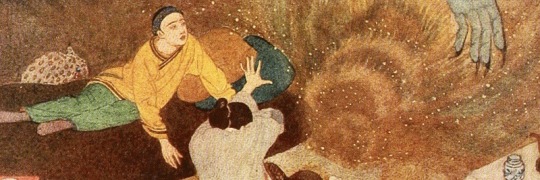
1001 Arabian Nights
The original story of Aladdin and his magic lamp was honestly very different from the Disney film. Beyond some basic plot points (princess in a castle being in love with a street boy, a genie, etc) the story is virtually different. The main apparent thing being that there’s not one, but TWO genies, and the evil schemer is a wizard pretending to be Aladdin’s uncle, not a vizier taking advantage of the king. On the whole, I think Jamil and Kalim would be interested but wholly unimpressed. Oh, also a lot of murder.
Jamil hummed as he looked at the last page, tilting his head to the side as he thought.
“Aladdin doesn’t…seem like a good person.” Kalim said, staring at the book Jamil was holding. “He just…killed someone?”
“Granted, it was to save the princess,” Jamil began, looking to Kalim for only a moment. He gazed back down, “I can understand something like that. However…”
“There’s a lot of…slavery in this story.” Kalim finished, messing with his fingers, “I don’t like that.”
“The Asim Family-“
“I would never want you to do something you don’t want to.” Kalim said solemnly.
Jamil went silent, looking out the window. He tapped his finger against the edge of the book, lost in thought. “I still do, though. There are plenty of things I do for you that I don’t like.”
There was a silence as Yuu looked between them. Kalim looked hurt, and ashamed. Jamil looked…carefully put together. But deeply uncomfortable.
Yuu cautiously reached forward, taking the book from Jamil, who didn’t acknowledge it but did allow them to take it.
“I’m quite interested in this Roc bird that’s mentioned,” Jamil said suddenly, “It is to be the master of all genies?”
“Maybe it commands Azul.” Yuu joked, thinking back to Jamil’s words just before he’d overblotted.
Jamil glowered in return, but this did earn a laugh from Kalim.
The vice housewarden turned to contemplate the coffee table rather deeply, then murmured, “This tale does ring similar to our history, but rather different. It’s…odd. Like they were cut from the same cloth.”
Yuu shrugged, “It’s just a story. Nobody really got hurt.” They assured when Kalim looked momentarily uncomfortable again.

Snow White
The Grimm telling of Snow White is also fairly similar to the Disney telling, with the exception of the Evil Queen being WAY more persistent in the murder thing. She attempts to kill Snow three times. The first by cinching her corset so tight that she passed out, but it was unable to kill her. She tries again by gifting her a poisoned hair comb, which again fails to kill her. The third time, the poisoned apple, is the charm. She bites the apple, goes into a coma, glass coffin blah blah blah. Prince finds her coffin, decides she’s a real babe and takes her and the coffin home with him. On the journey back, one of the prince’s servants trips and knocks the coffin into something, which somehow manages to dislodge the piece of apple in the princess’s throat and bring her back to life. Yay! Then she tries to kill her again, fails, and is punished to dance in red hot slippers until she dies. Yay…?
Vil and Rook sat on opposite sides of the couch. Rook was staring pointedly at the wall while Vil was staring directly at the hunter.
“It’s quite interesting-“
“Not a word out of you.” Vil cut him off, turning his attention to his nails instead.
Yuu sat across from them, snapping the book shut to put it away, “Maybe this wasn’t a great idea.”
“You think?”
Rook looked like he wanted to say something, a finger up as though he were conducting an invisible choir.
“Rook Hunt. Keep your mouth shut, you fucking traitor.”
“You said you wished for me to be true in my heart!” He defended.
Yuu took this as the moment to leave the room, clutching the book close,
“Spudling, where are you going? Come back here.”
Yuu squeaked nervously before coming back to stand in front of him, a sheepish smile on their face, “Hmm?”
Vil looked them up and down, before leaning forward to straighten Yuu’s clothes, “Spudling, is this why you were so nervous when Trappola and Spade ate that apple tart?”
“I honestly kinda thought you killed them.” Yuu admitted with a titter.
Vil’s eyebrows shot up as he glanced to make eye contact with them, “Do you think I’m so cruel?”
“I didn’t know what to think.” They said honestly, hands reaching to stop Vil’s from moving, “All I knew was that Rook calls you the king of poisons, and my friends suddenly collapsed after eating apples. Two and two together lead to poisoning.”
Rook began to laugh loudly, then coughed to cover it and continued to not look at Vil.
Vil frowned, “I would never kill anyone, Spudling-“
“Except Neige.”
“NEIGE KNOWS WHAT HE FUCKING DID-“

Sleeping Beauty
Honestly this one is too graphic for me to explain in detail but let’s just say that the prince is even worse in this one than in the Disney version. Consent isn’t even a question for him he does not care. Also the cure in this version was kind of similar to snow white’s, in which a fragment of the spindle is stuck in Briar Rose’s finger and once it is dislodged she’s freed from the curse. Seriously though, wouldn’t recommend looking this one up to anyone who’s faint of heart. It’s seriously gross.
Malleus and Lilia don’t seem to surprised as you finish the tale. In fact, they don’t even bother to keep talking about it, and it’s totally not because the author of this doesn’t want to get into how absolutely disgusting it is that the 100 year old 16 year old has two kids that she definitely didn’t want, or how fucking gross the prince is to do what he did, it’s because they’re old as fuck and already kinda knew.
Lilia just goes back to setting your kitchen on fire while Malleus decides he’s going to read every other fairy story except this one because this one sucked and his grandma didn’t even turn into a dragon :/

Alice in Wonderland
Strictly speaking, the 1950’s animated film of Alice in Wonderland is not all that different from its inspiration. Most story beats are faithful to the original, with the exception of tweedle dee and tweedle dum, which actually appear in the sequel Alice through the looking glass. It appears that within Twisted Wonderland’s universe, while there is some misinterpretation of the Queen of Hearts herself, the information given in the film is well known based off of the comments given in the ‘chats’ with each character. It is unknown whether the Tim burton films have any bearing on twisted wonderland’s history, though based off of Riddle’s design and character it appears it may have been a source of inspiration at the least. All of this is to say that none of this particular story would be much of a surprise to any of the characters, as for them it’s very grounded in reality. This isn’t to say there wouldn’t be a surprise, though….
Riddle had been quietly sitting on the couch reading a book for about an hour now. It seemed as though he was nearing the end, and he looked both confused and enraptured by it.
“What’s that?” Yuu asked.
Riddle looked up, and with a carefully crafted blank face he held up the book so they could read the cover.
Alice’s Adventures in Wonderland by Lewis Carroll
“Ah,” Yuu said nervously, “Good read?”
Riddle tilted his head, “You never told me there were stories of twisted wonderland in your world.”
“That’s cause it’s not twisted wonderland.” Yuu defended, “That’s just regular wonderland.”
“The difference being?” Riddle asked, tone taking on a biting edge.
“It isn’t twisted?” They tried, shrugging, “I didn’t think it would interest you, honestly. It’s a lot of the same stuff as history class.”
Trey took this EXACT moment to walk into the room. He took one look at Riddle’s twitching eyebrow and realized that, oh shit, time to intervene. “What’s going on here?” He asked tentatively.
“This- ah…” Riddle took in a deep breath, trying to calm himself, “This world has stories of Wonderland. Yuu neglected to mention this, in my opinion, rather imperative information.”
Yuu shrugged, “It’s just a children’s story. What could be so important?”
“Perhaps the fact that someone travels to and from Wonderland?” Riddle bit back, “Or perhaps that if your world has information on ours, then it isn’t fiction?”
Yuu blanched for a moment before calming themself. “Riddle,” they began, frowning, “I’m sorry. I didn’t think of that. But I have a very…different look on it.”
Riddle raised an eyebrow, urging Yuu to continue. Trey in the midst of this sat down beside Riddle, taking the book from him.
“This was written by someone named Charles Dodgeson, also known as Lewis Carroll. He wrote this for a trio of girls he used to tutor and babysit.” Yuu began, sitting down on the coffee table in front of Riddle and Trey. “He would often take them on canoe rides and tell them stories, making it up as he went along. He favored one particular girl, named Alice Liddell, and favored to write the story about her.”
Riddle looked unimpressed and confused at the same time, “But-“
“Riddle.” Trey said softly, “Let them continue.”
“Dodgeson was eventually fired by the Liddell family due to what was described as a ‘family affair’, the nature of which was never known. After that, for a bit of money he printed the story and sold it, then made wrote a sequel called ‘through the looking glass’.”
Riddle and Trey sat in silence before Riddle piped up, “Through the Looking Glass?”
“Mhmm.” Yuu said, “Alice returns to wonderland after walking through an enchanted looking glass. The rest of the adventure is similar to the first, changing from moment to moment.”
Riddle stared, fists curled in a ball and shaking. “So there’s a way home?”
Yuu looked surprised, “N-no, Riddle, it’s just a stor-“
“IT’S NOT JUST A STORY!” He cried, “It has to be real, you see that don’t you? You got to our world through a mirror, we got stuck here through one too. So there’s got to be another way back! Alice- Alice is real. She had to have gone….” He began to settle down, eyes filling with unshod tears.
Trey looked between Yuu and Riddle, “He’s right. It…would make sense. And…that’s a pen name, isn’t it? How do we know Alice didn’t write that?”
Yuu looked lost, staring down at the sobbing Riddle, who was murmuring various incoherent thoughts all in a long string.
“I’m so, so sorry…” Yuu said quietly, “We…I didn’t….I’m sorry. We can look, okay? I’ll do some research. We’ll get you home…”
#twisted wonderland#twst headcanons#twisted wonderland headcanons#azul ashengrotto#twst#jade leech#floyd leech#twst mc#riddle rosehearts#leona kingscholar#ruggie bucchi#trey clover#kalim al asim#jamil viper#malleus draconia#lilia vanrouge#vil schoenheit#rook hunt#pomefiore#heartslabyul#savanaclaw#diasomnia#scarabia#octavinelle
667 notes
·
View notes
Text



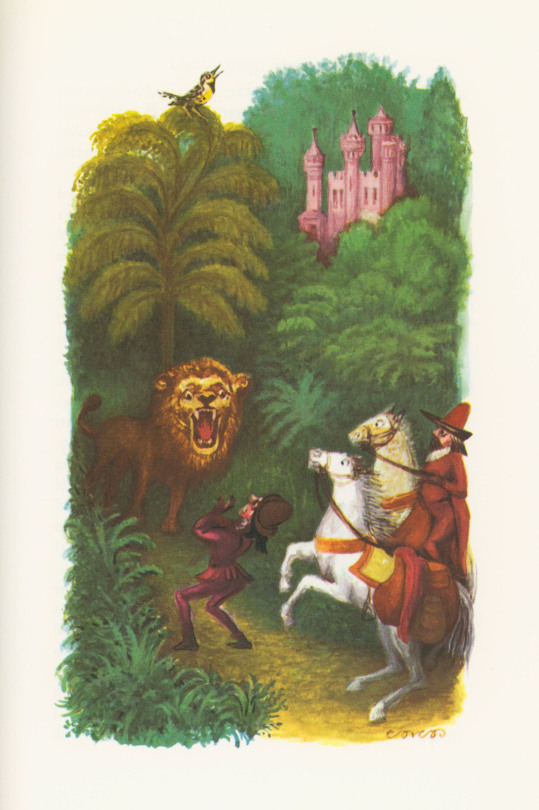



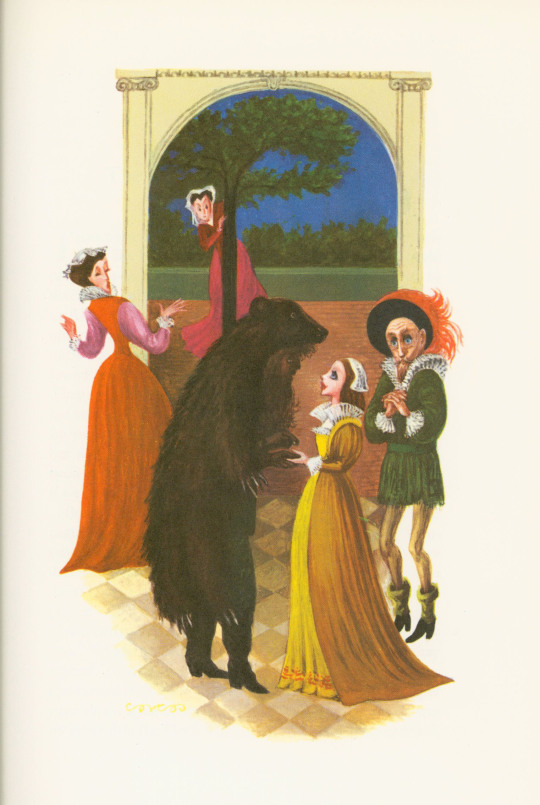


Milestone Monday
Today, February 26th, is national Tell a Fairy Tale Day and for those needing some inspiration, we’re sharing Grimm’s Fairy Tales edited by Louis (1885-1977) and Bryna Untermeyer (1909-1985). This four-volume set was published in 1962 by The Limited Editions Club (LEC) and contains the complete collection of stories accompanied by Andrew Lang’s essay on the origin of the tales. It is illustrated by the prolific modern primitivist painter Lucille Corcos (1908-1973) who created vibrant full-page watercolors printed by color lithography and monochromatic drawings interspersed within the text.
The Brothers Grimm studied folklore and German literature while attending university and first began collecting oral folk tales at the request of two poet friends who wanted to publish a book on the matter. In 1812 the first edition of Kinder-und Hausmärchen (Children and Household Tales) was published containing 86 stories, a second volume with an additional 70 stories followed in 1815. Their collection would become one of the most influential works of folklore in the world, translated into over 160 languages and countless adaptations for opera, film, and a range of media. We also happen to hold the first English-language edition of Kinder-und Hausmärchen, a two-volume set entitled German Popular Stories, published in London, 1823-1826, with illustrations by George Cruikshank.
Our copy of the LEC's Grimm’s Fairy Tales was a gift from Loryn Romadka from the collection of longtime LEC member Austin Fredric Lutter of Waukesha, Wisconsin.
Read other Milestone Monday posts here!
– Jenna, Special Collections Graduate Intern
#milestone monday#grimm's fairy tales#brothers grimm#tell a fairy tale day#louis untermeyer#bryna untermeyer#the limited editions club#LEC#andrew lang#lucille corcos#Jenna
25 notes
·
View notes
Note
Hello! I'm really curious, what books/authors would you recommend to someone who's new to writing horror?
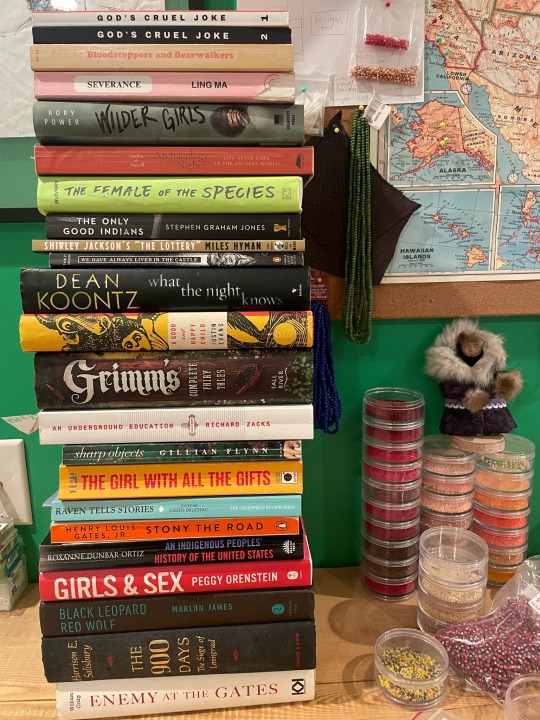
Hi! Here is what I have on hand (minus my loaned out copies of my favorite book ever Mongrels by Stephen Graham Jones and Never Whistle At Night: an indigenous anthology of dark fiction which made me cry on an airplane and made the person next to me very uncomfortable, like she was just trying to build a cart at banana republic, apologies to seat 17B)
God’s Cruel Joke Lit Mag because I’m in them and will be in issue 4, too :) published either mid-January or February 2024– @labyrinthphanlivingafacade is in issue 3 with a great short story that I won’t spoil ***right now the magazines are available to purchase in physical copies but I was told all issues will be free to download as pdfs pretty soon!
Severance by Ling Ma (body horror but not in the way you think, the real horror is repetition and loneliness)
Wilder Girls by Rory Power (body horror)
The Female of the Species by Mindy McGinnis (adjacent the horror genre but a hell of a read)
ANYTHING BY STEPHAN GRAHAM JONES ANYTHING
We Have Always Lived in a Castle by Shirely Jackson (I read this for the first time last spring boy howdy, I also included The Lottery for its suspense)
Dean Koontz because my husband suggested it for the list— this was just the first title I grabbed, I think he said Patrician Crowell too but I was busy looking for Mongrels
A Good and Happy Child by Justin Evans (I didn’t finish this because depression set in shortly after I started but the first chapter plays with second pov which I really liked, I’m determined to read it this year)
Sharp Objects by Gillian Flynn (I really enjoyed HBO’s adaptation)
The Girl With All The Gifts by M.R. Carey (likely the only zombie stories that made me weep uncontrollably)
Girls & Sex by Peggy Orenstein (non-fiction: explores modern young women navigating sexuality and because I have a thing for loss of autonomy— it’s been a few years since I read it but there is discussion of sexual assault, but I appreciate the expanse of her research and even included a conversation with someone who is asexual)
Black Leopard Red Wolf by Marlon James (got a chill just typing this out— the audio book is exquisite)
You’ll notice some nonfiction because, as a historian undergrad, nothing scares me more than man. The battles of Leningrad and Stalingrad are particularly stomach churning. America’s Reconstruction Era is full of acted out malice and under taught in my opinion.
An Indigenous People’s History of the United States by Roxanne Dunbar-Ortiz
The 900 Days, The Siege of Leningrad by Harrison E. Salisbury
Enemy at the Gates by William Craig
(On the other side of WW2 I have a book of the experiences of German solider’s left over from a paper I wrote on the inadequacy of Nazi uniforms and how it expedited their failure in Russia, Frontsoldaten by Stephen G. Fritz)
Stony the Road by Henry Louis Gates, Jr (one of my favorite authors, try finding “How Reconstruction Still Shapes American Racism” Time Magazine, April 2, 2019, I used it as a source for a paper on the history of voting rights)
Bloodstoppers and Bearwalkers— folk tales of Canadians, Lumberjacks & Indians by Richard M. Dorson (published around 1952 but content collected from the Upper Peninsula of Michigan in the 40’s)
Raven Tells Stories: An Anthology of Alaskan Native Writing (I’m Alutiiq and the museum on Kodiak has a lot of stories recorded under Alutiiq Museum Podcast— my kids and I listen on Spotify)
I think the genre of horror is really mastering tension and playing on peoples fears which is why I included old school folk stories (An Underground Education had a great write up on the Grimm Brothers and the original fairy tales from around the world such as the Chinese and Egyptian Cinderella, as well as several different sections of funny tales, torture techniques, absolute weirdos etc etc) in this vein of thought The Uses of Enchanment: The Meaning and Importance of Fairy Tales by Bruno Bettelheim could prove to be useful
If you’re writing a character with Bad Parents— Adult Children of Emotionally Immature Parents and Toxic Parents (it has a longer subtitle but I don’t see my copy anywhere) might be able to help you shape character traits
I reached out to @littleredwritingcat who has a mind plentiful in sources who recommended
The Gathering Dark: an anthology of folk horror (I will be picking this one up asap)
Toll by Cherie Priest (southern gothic)
Anything by Jennifer MacMahon
The Elementals by Michael McDowell
#book recommendations#answered#is that my ask box tag? I never get them and forget everytime lmao#I feel like I should have prefaced this with how I’m just dipping my toes into horror myself#so I’d love to hear what other people are reading too!!!!
27 notes
·
View notes
Text
Snow White and the Seven Dwarfs is one of the most famous fairy tales in the world, first related in 1812 when the Grimm brothers published their collection of tales that had been gathered from old European folk stories.
13 notes
·
View notes
Text
Some scholarly notes about the Grimm fairytales (2)
A follow-up of this post.

The Frog King or Iron Henry (Der Froschkönig oder der eiserne Heinrich)
This story belongs to the AaTh 440, "The frog-king".
The story first appears in the 1810's manuscript, written by Wilhelm - it was probably told by Henriette Dorothea "Dortchen", Wilhelm's future wife. A second version, called "The frog prince", had been told to them by their friend Marie Hassenpflug and was published in the 1815 edition as the thirteenth tale, before being moved to the notes of the 1822 due to its too-great similarity with the KHM 1.
This fairytale was originally called "The king's daughter and the bewitched prince". The 1810 manuscript has, written by Jacob right next to the title, "The frog-king", while the paper on which he had placed all his notes about the fairytale bore the name "Iron Henry". The evolution of this fairytale is very interesting because it testifies the brothers' love and care for details, hich had the story double in sie throughout the editions. In the final text we have, for example, a long sentence describing how the princess sees the ball fall into a well so deep she can't see the end, and about her crying a lot and lamenting, etc, etc... In the 1810 manuscript it was just one short sentence "She stood near the well and she was sad."
The major editing of this tale was the removal of the erotic motif from the tale's ending. Originally, the frog asked the princess the authorizaton to sleep in her bed, and right after the frog became a human it was written "the princess joined the prince in bed". This, plus the addition by the Grimms of moral lessons delivered by the father (the king tells things such as "You must always keep your promise" and "You must not disdain the one who helps you"), completely changed the goal and purpose of the tale - it was originally about setting free an animal husband, but the Grimms turned it into a moral tale to learn a virtuous behavior.
The brothers Grimm considered this fairytale to be the oldest and most beautiful of their collection. Allusions to the frog-king tale can be found as early as the Middle-Ages and the 16th century. In the 1801 edtion of the 1548 Scottish book "Complaynt of Scotland", a note evokes how a tale is similar to "The Frog Prince" due to having a well, the presence of magic, and a frog complaining in rhymes. In this Scottish version, a girl is sent by her stepmother to fetch water at "the well of the world's end". There she meets the frog, who tells her it will offer her water only if she agrees to marry it - if not, the frog will rip the girl apart. The brothers Grimm themselves noted various literary sources for their tale, that they used in their compilation work. The name of Henry (Heinrich) comes from the novel "Der arme Heinrich" by Hartmann von Aue. They also listed the "Froschmeuseler", a didactic epic by Georg Rollenhagen depicting a war between frogs and mice: the association of sadness with "rings of iron" comes from this text, as well as the very name "frog-kng" which is found in the title of the second chapter "Tale of the encounter between Thief-of-Crumbs, son of the mice-king, with the frog-king".
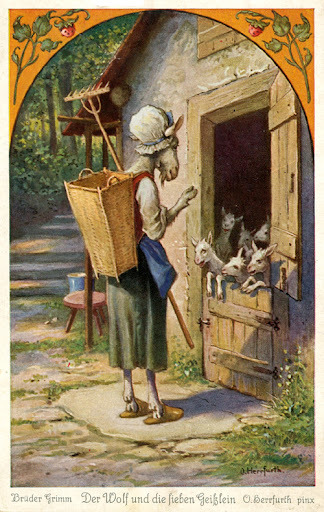
The Wolf and the Seven young Goats (Der Wolf und die sieben jungen Geiblein)
It is the AaTh 123, "The wolf and the lambs".
Collected in the "region of Main" according to the Grimm, it is very likely that the brothers Grimm received this tale from someone of the Hassenpflug family, as they knew the French fables of La Fontaine which correspond to this fairytale. In the 5th edition of their book, the brothers Grimm modified their story due to the publication in 1842 of an Alsacian tale by Ströber, "Die sieben Gaislein", "The seven young goats" (collected in Volksbüchlein, "The Folks' Small Book) - Wilhelm Grimm borrowed several expressions from this text. The brothers Grimm listed this Alsacian tale in their notes.
In their notes the brothers Grimm listed a Pomeranian version about a child who, when his mother is out, is swallowed by a sort of bogeyman known as "The children's ghost". But since the ghost eats stone at the same time, he becomes slow and heavy - he falls and the child can escape his belly unharmed. The brothers Grimm also listed variations collected/written by Boner in his Edelstein, and by Buckhard Waldis - as well as the La Fontaine fables. They also knew of a French fairytale, from which they noted a passage where the wolf asks a miller to turn her paw white with flour, and since the miller refuses, the wolf threatens to eat him. The Grimms linked the episode of the wolf's belly filled with stones with the legend of a Nereid called Psamathe, who sent a wolf destroy the flocks of Peleas and Telamon, only for the wolf to be petrified.
This tale, like many others within the Grimm's collection (it is especially comparable "Cat and Mouse in Partnership) is aimed at educating young children, with the narrator highlighting how children should be wary and distrustful of the wickedness and cowardice of men. Unlike other versions and predecessors of the tale, the brothers Grimm insist on the mother's role as a teacher, and on the fact that she saves her kids.
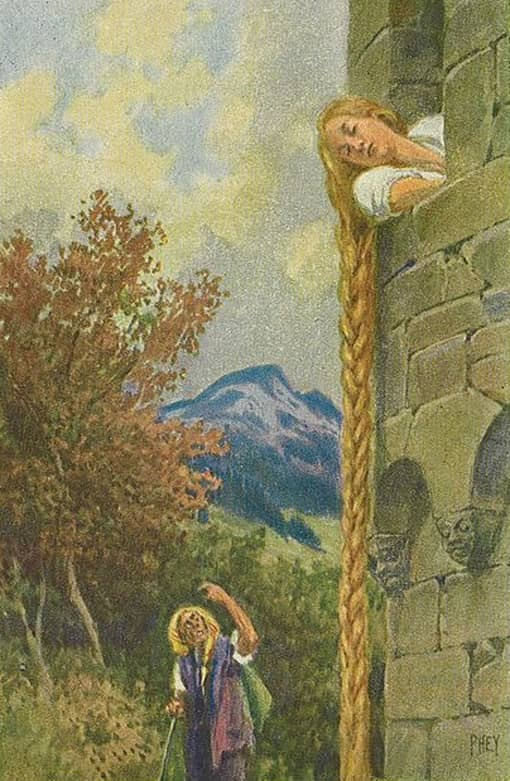
Rapunzel
It is the AaTh 310, "The maiden in the tower".
The literary sources of this fairytale are well-known. It was preceeded by the French literary tale "Persinette", by mademoiselle de La Force, itself inspired by Basile's story "Parsley Flower". In their notes the brothers Grimm explained they took inspiration from the almost-literal German translation of mademoiselle de La Force's story by Friedrich Schulz. However, in quite a misunderstanding, the brothers admired this tale as being an obvious "folktale" coming from the "oral tradition" - when we know it was a literary fairytale, though based on a folkloric motif.
The text was heavily edited after the many criticism the first edition of the book underwent - the scene depicting the prince's relationship with Rapunzel was regularly changed. In 1837 it is written that the prince asked Rapunzel to marry him almost right away, and she agreed since he was young and pretty, and they "held hands". In 1819, it was written that they lived together in "joy and pleasure" for a certain time, and "loved each other like woman and wife", and the "fairy" only realizes something is up when Rapunzel blurts out it is easier to make the prince climb than her "godmother". In the 1812 edition, it is said that Rapunzel and prince lived together in "joy and pleasure", but no mention of any marital couple whatsoever - and Rapunzel betrays her condition to the "sorceress" because she complains about her clothes getting too tight.
The Grimm noted that many versions of the "girl in the tower" fairytale existed, but with a different opening relying on the "forbidden room" motif: the witch punished the girl by locking her up in a tower because she had opened a door the witch explicitely forbade her to. The Grimm also listed several stories (outside of Basile's version) where a mother (sometimes a father) bargains their future child to satisfy a temporary craving - such as the Nordic "Alfkongs-Saga", where Odin offers Signy's wish for the better bear in the world in exchange of what is "between her and the barrel", aka the child she bears. In a book of Büsching we find a girl named "Petersilie" (Parsley in German) which loves eating prasley more than anything in the world and brushes her long hair by a window. The idea of using hair as a rope or ladder, long before Basile used it, seems first recorded by from the "Book of the Kings" of the poet of Persia Firdoussi, in the 10th century: the hero, Zal, joins the beautiful Roudebeh by climbing up her braids.
The name the sorceress wears in the German tale, "Frau Gothel", had been explained by the Grimm in such a way: "The godfather is not only called Vater (father) but also Pathe (godfather/"parrain" in French), or Goth or Dod ; the baptized child is also called "Pathe" or "Gothel", hence the confusion of the two within the legend". So, the dominating hypothesis (which seems confirmed by the variations of the fairytale) is that "Gothel" means "godmother".
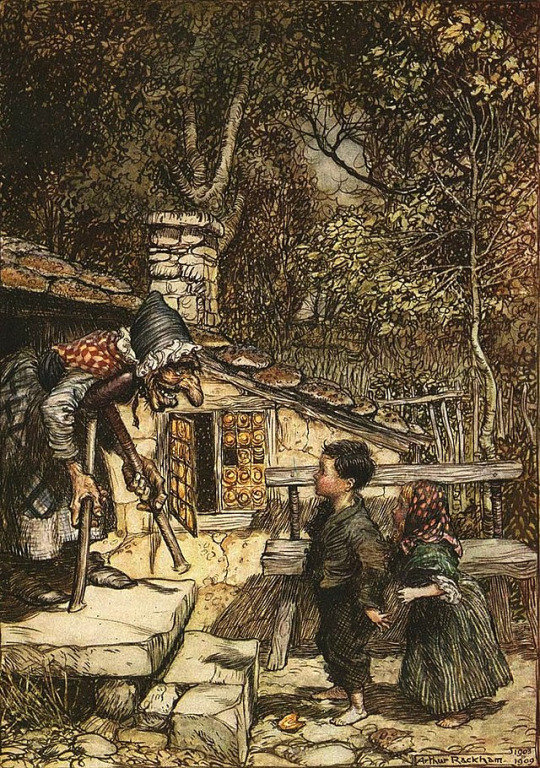
Hansel and Gretel (Hänsel und Gretel)
It is of course the AaTh 327 A, "Hänsel and Gretel" (a subtype of "The children and the ogre"). It also covers the AaTh 1121, "Burning the witch in her own oven".
In the 1810 manuscript this fairytale was called "Little brother and Little sister", a name that would later be reused by another famous Grimm fairytale (KHM 11). It seems that one of the reasons for the Grimm's big edits on this tale was the publication in 1842 of the Alsacian version of this story by August Stöber, "The little house of pancakes" (Das Eierkuchenhäuslein) - which itself was inspired by the Grimm's original publication of "Hansel and Gretel" (full loop here). Wilhelm Grimm notably borrowed several turn of phrases from Stöber.
The motif of the children abandoned in the woods can be found back in Basile's Nennillo and Nennella, though the extension to the encounter of a child-eating monster is rather present within Perrault's Petit Poucet and madame d'Aulnoy's Finette Cendron (both also contain the motif of the treasures inside the ogre's house). While we know the Grimms were aware of Perrault's story, we also know that madame d'Aulnoy's fairytales, including "Cunning Cinders" had been brought to Germany by ther adaptation for the German branch of the "Bibliothèque Bleue" - Blaue Bibliothek. Ludwig Bechstein's own version of "Hansel and Gretel" was very famous - and he actually wrote it inspired by the German translation of Stöber's own tale.
The motif of ashes, crumbs or seeds left behind to tell the way is recurring within the brothers Grimm fairytales: it also appears on the KHM 40 (The Robber Bridegroom) and 169 (The Hut in the Forest), as well as in their first "Legend for children". This motif can be found back in German literature to 1559's Gartengesellschaft (The company within the garden) by Martin Montanus, where it appears in the tale "The small earth-cow", Das Erdkühlein.
It is recognized that this fairytale is the second most popular and famous Grimm fairytale right after Snow-White. It was heavily illustrated - first by none other than Ludwig Emil Grimm himself (another brother of the Grimms). As we said before, Bechstein's own fairytale was a strong "rival" to the Grimm's, and was illustrated by Ludwig Richter in 1853. The motif of the "bird leading to the Ohterworld" is found back in the KHM 123 (The Old Woman in the Wood), and in both cases the fact the bird is white indicates that it is an Otherworldy animal.
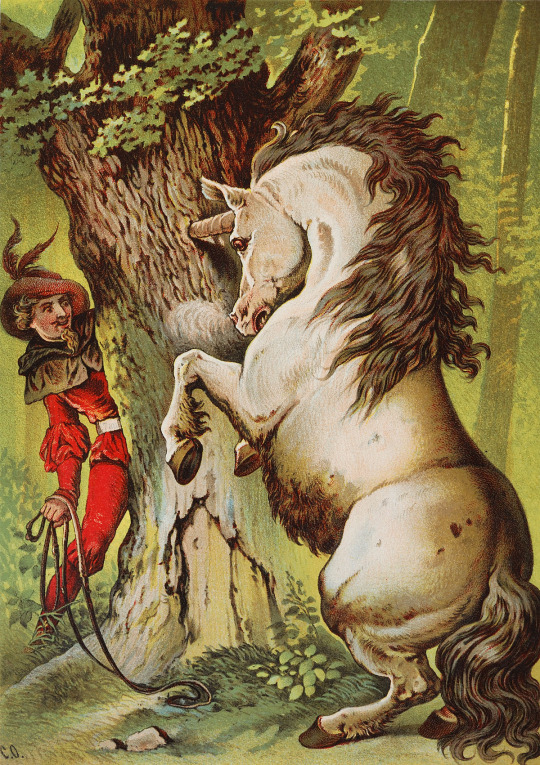
The Brave Little Tailor (Das tapfere Schneiderlein)
This fairytale belongs to many different Aa-Th types: 1640 (The brave little tailor), 1051-1052 "Curb, cut and move a tree", 1060-1062 (Throwing-stone conquest), 1115 (Attempt to kill the hero in his bed).
The 1810 manuscript began with this tale as its opening, probably as an homage to Brentano, since Wilhelm Grimm found this tale within his library, in a book called "Wegkürtzer", by Martin Montanus.
Among the modifications of the 2nd edition, a very interesting one is the addition of a sentence closing the first paragraph "and his heart moved with joy like the tail of a small lamb". This sentence comes from a novel by Christian Weise calle "The three most mad madmen in the whole world/The three most foolish fools in the whole wide world" (1762). Wilhelm Grimm explained this, as well as several other similar "borrowings", in the preface of the sixth edition, as his desire to insert in his tales specific sentences and expressions he knew to be typically German.
The brothers Grimm notd that Montanus' Wegkürtzer was frequently alluded to within the Renaissance literature and the baroque one - for example, when Johann Fischart translated in German Rabelais' Gargantua he inserted the sentence "I will kill all these flies, nine at once, like this tailor once did." It was also evoked in the "Simplicissimus" of Grimmelshausen, but references to the Little Tailor story go back to the Middle-Ages. The episode of a giant crushing a stone until water comes out of it is found in "Brother Werner", from the Codex Manesse (which compiled German Minnesang, courtly poetry) ; and Heinrich von Freiberg's Tristan describes at one point the hero crushing a cheese until juice comes out of it. Montanus' text was also used by Ludwig Bechstein in his book of German fairytales. One can compare the story of the Grimms to Tabart's "Jack the giant-killer" and Afanassiev's "Foma Berennikov".
The measurements in this story make no sense at all. The tailor buys four half-ounces of marmelade. Given an ounce was roughly 32 gr, the tailor bought 60 gr roughly... Not a quarter of a pound, as he claims. The reason for this incoherence is because, before 1854, a "pound" varied depending on which area of Germany you were into (it was 467 gr in Berlin, 510 in Nuremberg). It was only in 1854 that the value of the pound was unified in Germany, at 500 gr. Finally we note the presence at the end of the tale of the common European belief n the "Wild Hunt".

Cinderella (Aschenputtel)
Of course, it is the Aa-Th 510A, "Cinderella".
As early as the first edition, this fairytale was a mix of several variations. In their notes, the brothers listed nine different versions of the tale. One of them is quite fascinating: the opening scene of the mother's death and her promises of help is missing, the story begins immediately on the heroine's misfortunes. The end of the version also greatly differs and enters the domain of the KHM 11 "Little-brother, Little-sister". Soon after his wedding with Cinderella, the prince forbids her to enter a specific room of the castle - but encouraged by her sister, she opens the room when the prince is absent. It contains a fountain of blood that Cinderella's sister uses for an evil use: after the queen gives birth to her first child, her sister throws her in the fountain and replaces her in the bed. But the guards of the castle hear the moans of Cinderella, rescue her and the wicked sister is punished. Another version, from Mecklembourg, has an ending which makes the tale close to the legend of saint Genevieve of Brabant: Cinderella's stepmother and stepsister steal away Cinderella's two first children and replace them with animals ; the third time she gives birth, they order the gardener to kill the queen and her child, but he rather hides them in a grotto in the woods, where the child is fed by a doe. One day the child, old enough, goes to the castle to speak to his father, revealing to him the fate of his mother.
Another version, this time from Paderborn, begins in a way very similar to "Snow-White": a queen wishes to have a child as red as a rose and as white as snow. She gets her wish, but then her servant pushes her outside of the window, to replace her as the king's wife. The usurper gives birth to two daughters, and from then on we return to the classical Cinderella tale - her dead mother helping her from beyond the grave by offering her a key, opening a hollow tree where Cnderella finds what she needs to wash herself and dress up pretty for the church (plus a prayer book). Büsching evoked the existence of another version in the Zittau area, where Cinderella is a miller's daughter that is forbidden to go to church, and where it is a dog that denounces the false fiancée. Outside of all these oral sources, the brothers Grimm took inspiration, of course, from Charles Perrault's Cinderella, as well as from the first German literary record of the Cinderella story, "Laskopal and Miliwka", published in an anonymous collection of legends in 1808 (Sagen der böhmischen Voreit aus einigen Gegenden alter Schlösser und Dörfer").
From the second edition onward, the brothers Grimm heavily edited the story. They removed all the words and passages that referenced too much Perrault's version, replacing them by elements taken specifically from the three versions they collected in Hesse (such as the demand for a branch of a nut-tree, and the motif of the tree growing on the grave). In the 1812 edition, it was Cinderella's own mother who advised her daughter to plant a tree on her grave, and who predicted that this tree will help her in the future. Throughout the rewrites, Wilhelm Grimm heavily insisted upon the heroine's virtues, accentuating them so that they would fit the feminine bourgeois ideal of the time.
The first European record of this tale is Basile's "The cat of the ashes", and other famous literary versions include Perrault's Cinderella, madame d'Aulnoy's Cunning Cinders, as well as Ludwig Bechstein's Aschenbrödel. These versions were massively spread throughout Europe, notably due to the "peddling literature", the cheap books sold by peddlers: they helped the "Cinderella" fairytale type becoming as popular as it is today, and it seems very likely they influenced all the versions of the tale that came after them.
In their notes, the brothers Grimm explicitely compared the motif of the shoe in Cinderella with the legend of Rhodopis, who had her shoe stolen by an eagle, and the pharaoh that found it had her owner searched throughout Egypt. However the motif of the animals helping a persecuted heroine (especially when it comes to splitting grains) is very common, and has been popularized by the Roman tale of "Cupid and Psyche".
This fairytale is closely tie to the KHM 130, "One-Eye, Two-Eyes and Three-Eyes", both sharing the idea of a young girl humiliated by her sisters, and who obtains a social ascension as a form of compensation. A. B. Rooth studied the evolution of the Cinderella fairytale-type, and its relation with other fairytale-types: they determined that it is very likely the "Cinderella" story was originally told as a sequel to the "One-Eye, Two-Eyes, Three-Eyes" story-type. Later, the second part of this story gained its own autonomy, and became the "Cinderella" we know today.
The sexual connotations within the motif of "trying on the shoe" has been repeatedly noted and analysed since the Grimms published their story. Jacob Grimm himself saw in this the remains of an archaic Germanic betrothing ritual. Heinz Rölleke highlighted another cultural ritual that involved the future husband of a bride removing her old shoes before marrying her. The idea of the slippers tied to a wedding is also found within the KHM 133 (The Shoes that were danced to Pieces).
The name of the heroine in Germa, "Aschenputtel" designates a type of kitchen girl who searches throughout the ashes, and thus "rolls" herself in them - but it also means figuratively an insignifiant and a dirty girl. It seems to derivate from the greek "achylia", cinders/ashes, and "puttos", female genital organs. A combination echoed by the French name "Culcendron", "Ashen-butt". By extension, the name "Aschenputtel" can also designate the younger brother when he is disdained by his brothers and considered to be an idiot by his family: there is a lot of male Cinderellas in folktales, especially in Northern and Central Europe, but also in all German-speaking countries.
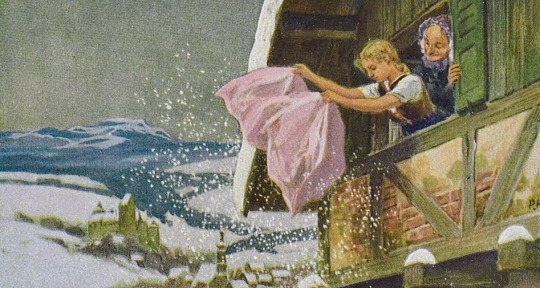
Frau Holle
Belongs to the AaTh 480 "The kind and unkind girls".
This story was told to Wilhelm Grimm by his future wife, Henrietta Dorothea Wild, who was then 18 years old. A secondary source was a tale told to their by the Hanovre pastor, Georg August Friedrich Goldmann - this second version contained the episode of the rooster saluting the girls. The second edition of the brothers Grimm's book added several details to this story to "rationalize" it - notably the Grimm added of their own an explanation as to why the girl jumps into the well.
This fairytale comes from Hesse and Westphalia. The brothers Grimm listed in their notes four other versions of it - and the first is more noticeable, because it echoes "Hansel and Gretel", as the house where the girls arrive is made of pancakes (crêpes). Older literary versions of "Frau Holle" can be found in Basile's Pentamerone (The Months, The Three Fairies), as well as within a French fairytale written by Gabrielle-Suzanne de Villeneuve, "Les nymphes" (The Nymphs). Translated in German in 1765, Villeneuve's fairytale notably inspired the Grimms when they composed their 1810 manuscript - they adapted her tale as their own story called "The marmot". Before the brothers Grimm, "ancestors" of "Frau Holle" can be found in various German fairytales, present in the collections of W. Reynitzsch (1802) and Benedikte Naubert (1789). Ludwig Bechsten did his own version of the fairytale (Gold-Mary and Pitch-Mary, Die Goldamaria und die Pechmaria) which had a huge success in Germany.
This fairytale belongs to a wide series of tales in which young girls leave their house to enter a far-away country which might be the Otherworld, and where they become the servants of a spernatural being. There, by performing tasks in a disinterested manner, they are rewarded. As with other fairytales, "Frau Holle" shows how the Otherworld and our world are inter-dependant with each other. "Frau Holle" had a huge mediatic success: it was adapted several times as movies, it is heavily present in children's literature, and it was heavily illustrated. The character of Frau Holle ("Holle" derivading from the Middle-High-German "hulde", "benvolent") is an ambiguous character, and shares several characteristic with Germanic water-spirits. She is a giver of supernatural gifts and goods, but she also punishes the wicked. This supernatural character is very present in German legends, especially in the oral tradition which associates her with the works of weaving and spinning. She might have her roots in the figure of a spirit in charge of women's initiation rituals.

Little Red Riding Hood (Rotkäppchen)
It is of course the AaTh 333: "Little Red Riding Hood".
The two versions the brothers Grimm used to create this story were told to them by Johanna Isabella and Marie Hassenpflug. Isabella's version was most notable for being an obvious transposition of Charles Perrault's fairytales - with two elements changed. The tragic ending was modifed so that the girl and her grandmother would be saved ; and the erotic connotations of Perrault's fairytale (where the wolf was presented as a dangerous seducer) were removed.
Charles Perrault's fairytale was also present in German literature through Ludwig Tieck's verse tragedy "The life and death of little Red Riding Hood" (Leben und Tod des kleinen Rotkäppchens), published in 1800. As for Ludwig Bechstein, he inspired himself from the brothers Grimm tale to create his own "Little Red Riding Hood". M-L-Tenèze has worked on collecting all the oral and popular versions of Little Red Riding Hood in France, its birth-country, and has identified its original format as it must have been told before Perrault: usually they end like his tale in a tragic way for the girl, but rarely she notices she is in bed with a monster and manages to trick it to escape. However a detail Perrault erased and that is present in these versions is how the wolf keeps a bit of the grandmother's flesh and blood, that he offers to the little girl as food.
The first version of this story, in the original edition of the brothers Grimm book, was much more didactic than the one we have today, heavily insisting on how the little girl should have obeyed to her mother, and how there are specific ways to interact with strangers on the road - and in fact, it seems that the reason this fairytale was so popular and widespread was precisely because of its didactic nature. Because everybody knows the "original" version of the Grimm better than the final one, their second and revised text that shows a heroine able to learn from her mistakes, and ending up defeating the wolf of her own without any outside help. It should be noted that the first version of the Grimm tale had an echoing motif with the KHM 5 "The Wolf and the Seven Young Kids".

The Musicians of the Town of Bremen (De Bremer Stadtmusikanten)
They eblong to the AT type 130 "The animals find a house for the night", more specifically the AT 130 B, "The animals flee after a death threat".
This fairytale, like many of those present in the brothers Grimm collection, was actually the fusion of two distinct stories they collected. The brothers Grimm described in their notes a literary source for this story: a long extract from "Froschmeuseler", a didactic epic by Georg Rollenhagen published in 1595 and which had animals as protagonists. In this text however, it is a dog that leads the six other animals (an ox, a donkey, a cat, a rooster and a goose). For this poem (of 20 000 verses) Rollenhagen himself had another literary inspiration: a first-century epic describing a war between frogs and mice.
The nicknames of the various animals were only added in the third edition of the book. The notes of the brothers contain a third version of the tale they did not use, and which mostly differs when they arrive at the robbers' house. Instead of chasing them away, the animals enter peacefully in the robbers' den, play music and are fed as a reward. Then the robbers leave, and when they return they send one of theirs to check if everything is alright in the house - and he suffers the fate described in the Grimm's final tale. There are other versions of the story where there are only two animals involved (a dog and a rooster), who get involved with a fox that the dog ultimately kills. In fact, the oldest versions of this tale all deal with domestic animals confronting, not human criminals, but rather savage animals of the forest. Outside of Rollenhagen's text, another literary precedent was a poem of Hans Sachs from 1551, where the house is inhabited by wolves.
The title of this story seems to refer to traditional mockeries of the music of the town of Bremen, which was a very famous city at the time. Anti-Aarne wrote an entire monography about this tale-type, "The travelling animals" (Die Tiere auf der Wanderschaft) where he highlighted how this story was the Western "sibling" of a more Oriental fairytale-type, the AaTh 210 "The rooster, the chicken, the duck, the pin and the needle are travelling". This tale is mostly present in the Far-East (Middle-East?), and very rare in Western Europe - but it is still present within the brothers Grimm's collection as the KHM 10 (The Pack of Ragamuffins), 41 (Herr Korbes), and 80 (The Death of the Little Hen). The oldest Western form of this other fairytale type is within the Latin poem by Nivard of Gand, 1150's "Ysengrimus", where animals considered too old are banished by their masters or about to be killed, and flee into the forest. The "Roman de Renart" (the Roman of Reynard) also contains ths motif in its eighth branch - and the ingratitude of mankind towards the creatures that served them all their life is also a theme of the KHM 48 (Old Sultan).
#german fairytales#grimm fairytales#brothers grimm#the frog king#rapunzel#hansel and gretel#cinderella#history of fairytales#evolution of fairytales#the musicians of the town of bremen#little red riding hood#frau holle#the brave little tailor
14 notes
·
View notes
Text
I’ve been thinking a lot about fairy tales and folk tales recently partially due to my own interest in the subject and partially due to the influx in live action remakes by Disney. And I’m torn between believing folk tales are integral parts of a culture and believing that they should be universal. These stories can be recast in different settings with different cultures in ways that cut the story from its original context. But this is part of the storytelling process in history because folk tales were past down orally for centuries and as a result, the exact same story was never told twice.
So I definitely see why changing races and cultures doesn’t matter. But I also think that European fairytales are considered the default when they are not. This allows them to be stripped of context and culture and reapplied in other settings (again- I don’t think this is inherently a bad thing. I see it as part of the larger tradition of storytelling. Stories have always changed to fit the audience who is listening). When European stories are considered the default, any non-European story is considered an outlier and is scrutinized differently. When it comes to Cinderella, similar stories appear in cultures around the world and while Europeans often depict her as blonde with blue eyes, her appearance is flexible so long as she’s seen as beautiful when she goes to the ball. Cinderella-esque stories are found in German, French, Greek, and Chinese cultures.
But Snow White feels kind of different as her story isn’t as universal and is very much rooted in the Brothers Grimm telling of a German tale. As far as I can tell, there really aren’t any Snow White stories from other cultures. Her appearance is important to the story, particularly her coloring. Skin white as snow and lips red as blood. Personally, I’d be inclined to leave the story as inherently German and preserve the appearances of the characters as they are described.
The Little Mermaid is also another story that comes to mind, as it’s roots are very firmly in Denmark and the nation seems to be pretty proud of the story. At the same time, mermaids aren’t real and Anderson wrote this story himself; he didn’t record an oral tradition the way the Brothers Grimm did. I haven’t watched the remake, but people seem to like it and while it strays from the original, the 1989 movie is also drastically different from the Anderson telling.
Now, I’m generally against the live action remakes because I think they’re unoriginal cash grabs that lack heart. It doesn’t matter to me who is cast in the role of a princess because I’m not going to watch the movie anyway. And even if I strongly disagree with a casting choice, I’m just not invested enough to bitch online. I just find it fascinating how people decide when a story can be separated from its roots and when it cannot. I’m curious to see what other people think
#I don’t really care much about the casting#this is just a thought I’ve had floating in my mind#I tend to really value and adore fairy tales#so while they are ‘just stories’#I also think they’re so much more#piml#Snow White#Disney#Cinderella#the little mermaid#fairy tales#folk tales#also most retelling of these stories have been with white people#so changing it up isn’t exactly throwing off the scales#just evening them a bit I guess
42 notes
·
View notes
Text
The Straw, the Coal and the Bean

The Brother's Grimm are probably the most well known authors when it comes to vintage fairy tales. However, what a lot of people don't know is a lot of their stories are not originals. Not exactly. Many of their stories are reinterpretations or retellings of old folk stories THEY heard. Which is why stories like this one, retold by the Brother's Grimm but seems to remain mostly untouched by Christianization, I find especially interesting.
The story of The Straw, the Coal, and the Bean is meant to give some explanation as to why beans always have a little seam. The type of bean is not mentioned, and Old Illustrations show bean variations from Green Bean to Kidney bean to Lima bean and more. Kitchen Witchcraft correlates all general beans with: Family, Harmony, Protection, Reconciliation, Co-operation, Wisdom, Luck, Money, Divination, and Prosperity. Perhaps this Fairy Tale/Folktale can give some insight as to why.
In a village lived a poor old woman, who had gathered together a dish of beans and wanted to cook them. So she made a fire on her hearth, and that it might burn the quicker, she lighted it with a handful of straw. When she was emptying the beans into the pan, one dropped without her seeing it, and lay on the ground beside a straw, and soon afterwards a burning coal from the fire leapt down to the two.
Then the straw began and said:
‘Dear friends, where do you come from?’
The coal replied:
‘I fortunately sprang out of the fire, and if I had not escaped by sheer force, my death would have been certain,—I should have been burnt to ashes.’
The bean said:
‘I too have escaped with a whole skin, but if the old woman had got me into the pan, I should have been made into broth without any mercy, like my comrades.’
‘And would a better fate have befallen me?’ said the straw. ‘The old woman has destroyed all my brothers and sisters in fire and smoke; she seized sixty of them at once, and took their lives. I luckily slipped through her fingers.’
‘But what are we to do now?’ said the coal.
‘I think,’ answered the bean, ‘that as we have so fortunately escaped death, we should keep together as good friends, and because a new trouble might find us here, we should go away together to a foreign country.’
The idea pleased the two others, and they set out on their way together. Soon, however, they came to a little brook, and as there was no bridge or foot-plank, they did not know how they were to get over it.
The straw hit on a good idea, and said:
‘I will lay myself straight across, and then you can walk over on me as on a bridge.’
The straw therefore stretched itself from one bank to the other, and the coal, who was brave, but still glowing from the fire, tripped quite boldly on to the newly-built bridge. But when she had reached the middle, and heard the water rushing beneath her, she was after all, afraid, and stood still, and ventured no farther.
The straw, however, began to burn, broke in two pieces, and fell into the stream. The coal slipped after her, hissed when she got into the water, and breathed her last.
The bean, who had prudently stayed behind on the shore, could not but laugh at the event, was unable to stop, and laughed so heartily that she burst.
It would have been all over with her, likewise, if, by good fortune, a tailor who was travelling in search of work, had not sat down to rest by the brook. As he had a compassionate heart he pulled out his needle and thread, and sewed her together. The bean thanked him most prettily, but as the tailor used black thread, all beans since then have a black seam.
#Brothers Grimm#Fairytale#Folktale#Food and folklore#Kitchen Witch#Kitchen Witchcraft#beans#the straw#the coal#Klickwitch#witch#witchcraft#october
21 notes
·
View notes
Text
Deep dives into folklore: German folklore
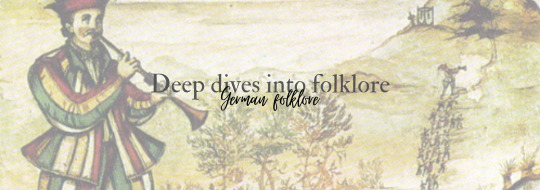
Embedded within the cultural fabric of Germany lies a trove of enchanting narratives, a testament to the nation's rich heritage and historical tapestry. German folklore, a captivating blend of ancient pagan beliefs, medieval epics, and timeless fairy tales, unveils a world steeped in myth and tradition. This essay embarks on a comprehensive exploration of German folklore, tracing its origins, introducing mythical figures, unraveling folk traditions, and assessing its profound influence on literature and popular culture. Within this intricate tapestry, the diverse tales of Germanic lore reveal not only the evolution of storytelling but also the enduring spirit that continues to captivate audiences across time and borders.
I. Ancient Roots and Pagan Influences:
Germanic folklore has its origins in the pre-Christian beliefs of the Germanic tribes. The pantheon of gods and goddesses, such as Woden (Odin), Thor, and Freyja, held sway over the imaginations of early Germanic people. The Eddas, epic poems preserved in Iceland, provide glimpses into the cosmology and mythology of the Germanic peoples, offering tales of creation, heroic exploits, and the prophesied end of the world, Ragnarök.
II. Germanic Mythical Figures:
The Nibelungenlied: The Nibelungenlied, a medieval German epic, tells the tragic tale of Siegfried, the dragon-slayer, and the curse surrounding the Nibelung treasure. This epic, with its themes of heroism, betrayal, and revenge, has left an indelible mark on German folklore and is a precursor to later literary works, including Wagner's operatic adaptation, "Der Ring des Nibelungen."
Brothers Grimm Fairy Tales: Perhaps the most famous collectors of German folklore, the Brothers Grimm, Jacob and Wilhelm, compiled a vast collection of fairy tales that have become timeless classics. Stories like "Cinderella," "Snow White," and "Hansel and Gretel" are embedded in global consciousness, showcasing the enduring appeal of German folk narratives.
III. Folk Traditions and Creatures:
German folklore is teeming with a diverse array of folk traditions and mythical creatures, each with its own regional variations. From benevolent spirits to malevolent beings, these entities populate the cultural landscape of Germany.
Kobolds and Elves: German folklore features kobolds, mischievous household spirits, and elves that are often associated with forests and natural landscapes. These beings, sometimes helpful, sometimes capricious, embody the close connection between the Germanic people and their natural surroundings.
The Lorelei: Along the Rhine River, the Lorelei is a legendary siren or mermaid who lures sailors to their doom with her enchanting song. This myth has inspired numerous poems and songs, becoming a symbol of the dangers and allure of the river.
IV. Impact on Literature and Popular Culture:
German folklore has left an indelible mark on literature and popular culture, both within Germany and globally. Beyond the Brothers Grimm's fairy tales, Germanic mythology has influenced literary giants like J.R.R. Tolkien, whose Middle-earth draws inspiration from Norse and Germanic mythologies.
Wagner's Operas: Richard Wagner's operatic masterpieces, including "Der Ring des Nibelungen" and "Tristan und Isolde," draw heavily from Germanic mythology. Wagner's reinterpretation of these myths has become iconic in the world of classical music and opera.
Contemporary Fantasy: German folklore continues to influence contemporary fantasy literature and film. Authors and filmmakers often draw on Teutonic themes to create worlds filled with magical creatures, quests, and epic struggles between good and evil.
German folklore stands as a testament to the enduring power of storytelling in shaping cultural identity. From ancient pagan beliefs to the enchanting tales of the Brothers Grimm, the narratives of German folklore have transcended time, leaving an indelible mark on literature, art, and popular culture. As these tales persist and evolve, they provide a window into the collective imagination of the Germanic people and invite ongoing exploration and reinterpretation in the ever-changing landscape of global storytelling.
Taglist (reply or reblog to be added): @axl-ul @crow-flower @thoughts-fromthevoid @alderwoodbooks @harleyacoincidence @tuberosumtater @sonic-spade @theonlygardenia @holymzogynybatman @nulliel-tres @w0rkah0licz @sylvanthorn @tigertaurus22 @profiterole-reads @mathias-musings @1899adgg1997tbmd @grimmparanormalinvestigations
#writeblr#writers of tumblr#writing#bookish#booklr#fantasy books#creative writing#book blog#ya fantasy books#ya books#writers block#national novel writing month#writers#teen writer#tumblr writers#writblr#writer problems#writerblr#writers community#writers corner#writers on tumblr#writerscommunity#writerslife#writing blog#deep dives into folklore#deep dives#german folklore#german mythology
10 notes
·
View notes
Note
Hello! I have a bit of an odd question, do andorians have any fairytale stories? If so, what kind?
Thank you.
Andorians do have fairy tales! In Emigre, Dagmar spends an inordinate amount of time translating some for the Andorian embassy, in fact.
The following is, of course, my headcanon lore rather than anything based in canon sources. Since, you know, there are none. (Do better, ST writers. Do better.)
Most Andorian fairy tales and folk stories tend to be more like the original Brothers Grimm stories rather than the newer, sanitised stuff peddled to children these days. Most of the stories are dark and are meant to serve as grim warnings to avoid or abstain from certain behaviours, or suffer the consequences. The foolish child who wanders off while their parent is distracted and falls through the ice, to be very graphically gobbled up by a sea monster, for example, is very popular with new parents trying to corral their unruly offspring. It's also remarkably effective.
Some are more fanciful, certainly, such as the tales of Andorians who wandered far from home and came back years later with eerily spectre-like Aenar wives, seemingly having never aged while decades had passed for everyone else. Others depict the Aenar as little better than fog-Spirits, melting in the presence of fire - which is a a thin metaphor at the best of times but especially telling when one considered that Andorians call themselves the people of fire.
Others still are tales of heroic adventures, often of young, enterprising heroes who set out to face challenges and change the status quo. The ones that live are hailed as heroes. The ones that don't are object lessons.
The less well known stories often feature heroes of previous tales who, rather than resting on their laurels, continue throughout their lives to step up to challenges and right wrongs in a continuous narrative from birth to death. Most of these lifelong heroes tend to die in a self-sacrificial move that benefits their families and Clan in some way, which should surprise absolutely no one familiar with the culture.
There are some points of contention between the different regions of Andoria regarding some of these stories, as it seems as though each region has a slightly different version of events recorded. All will agree, for example, that there was a Hero who may or may not have been young or old, who may or may not have been male or female, who may or may not have been a child of this Clan or that Clan or no Clan at all, who may or may not have faced these monsters but not those ones, slain these foes and formed alliances with those, and so on. It has been an absolute nightmare for historians who specialise in the preservation of ancient folklore to sort out, and most of them are locked in vicious debates with one another over the tiniest of details.
Thanks for the ask! <3
#star trek#andorian#andorians#headcanon#andorian fairy tales#andorian folk tales#andorian cultural headcanons#andorian culture
6 notes
·
View notes
Text
Addendum to Overview and Criteria for Gothic Fiction
When I wrote this thing about gothic novels I only mentioned Friedrich Maximilian Klinger's stageplay Sturm und Drang that premiered in 1777 and lent its name to a proto-Romantic artistic era in Germany.
I completely neglected to consider the influence of Jacob and Wilhelm Grimm's Kinder und Hausmärchen or "Household Tales" published on the 20th of December 1812, because I was focusing on English-language gothic literature, and Margaret Raine Hunt did not translate this collection into English until 1884. (I elected not to measure how many upperclass Englishwomen would be educated to fluency in German before a translation of the Grimm's text was published.)
The Picture of Dorian Gray is a novel by Oscar Wilde published in April 1891. He published a collection of shorter fairy tales before, The Happy Prince and Other Tales in May 1888, but like Wilde's technically-perfect-yet-passionless aesthetic poetry I personally consider them rather twee or prankish. The Picture of Dorian Gray makes a more interesting showcase of gothic fairy tale.
Literary critic and gold-trophy Worst Human Being in History of the Year 1814 Marquis Donatien Alphonse François de Sade keeps turning up in my gothic literature research like a bad penny. (I've read the Marquis's books, they're horrible, I hated them.) His literary criticism remains connected with the gothic, having first theorized in Idée sur les Romans (translated into Some Thoughts on the Novel) that the upheaval and slaughter of the French Revolution inspired authors to get some horror into their Romanticism, and also that the introduction of the Supernatural in the gothic novel posed a dilemma innate to the genre: Either it gets explained, and then the mystique is gone (I'll say this is me about Old Gods of Appalachia when the witches turned cosmic horror into calculated urban fantasy)...or it never gets explained, and then the reader remains at a loss (I'll say this is me about Picnic at Hanging Rock).
What I think the Marquis didn't consider, because The Picture of Dorian Gray was long after his time, was Wilde's creation of a marvelously original "Zaubermärchen" (magic fairytale)—the poetic justice, and the poetic logic that is exhibited in such a way that it only needs intuition rather than explanation. Dorian Gray is so sure he figured something out about his wish, so exactly, but the way the "magic" in this gothic 19th-century fairy tale truly operates makes a tidy and particular sort of sense that is magic of its own.
Grimm, Jacob, and Wilhelm Grimm. The Original Folk and Fairy Tales of the Brothers Grimm: The Complete First Edition. Translated by Jack Zipes, Princeton University Press, New Jersey: 2016.
@rwoh I'm trying to practice dual-mode citations what is this
Grimm, Jacob, Grimm, Wilhelm & Zipes, Jack (Trans.). (2016). 😥 ...wat whas that... The Original Folk and Fairy Tales of the Brothers Grimm: The Complete First Edition. Princeton University Press.
de Sade, Donatien Alphonse François. Some Thoughts on the Novel. Translated by R.J. Dent, Oneiros Books, 2021.
de Sade, Donatien Alphonse François, and R.J. Dent (Trans.). (2021). Some Thoughts on the Novel. Oneiros Books.
I don't have to cite The Picture of Dorian Gray, right? You all are the dark academia subculture, you all know by now what The Picture of Dorian Gray is.
#gothic literature#goth lit#dark academia#The Picture of Dorian Gray#Oscar Wilde#the Marquis who must not be named
6 notes
·
View notes
Text
stories as a vessel for human history: an essay by lee jihye
In writing an essay for her history class, one of the first ones she's taking in university, Lee Jihye can't help but feel a little too much on the topic.
Or: You are Lee Jihye and you are trying to be a good student, but you're not sure you know how to be good, much less a student when the last time you were a student you—
also on ao3.
.
.
.
Topic: Human history passed down via stories.
…much has already been discussed about written history through personal diaries and letters. Documents that have survived from the Roman Empire are, perhaps, among the best examples, containing a glimpse into the author’s life, the culture of the time, and the language used. Writings from the Roman Empire also include quotes from plays that have been lost to time and are only known for those few remaining lines. Many works of the Ancient Greeks also survive this way.
There are many written documents that survive to the modern day and have been preserved physically and digitally through copying and digital archiving. What is less discussed are living stories. Stories and accounts of different periods of history passed down through people. An oral history that is shared through speaking and art. Nontraditional stories include cave paintings, preserved human footprints from early humans, embroidery and other craft arts passed down through families and sold in estate sales.
Pieces of the lives people have lead left behind to be found and
You sigh, leaning back in your chair. This is still just the introduction of your essay and it’s taken you a full hour to write. It’s not even done yet.
University is horrible. It’s necessary for you to get a decent job in whatever field you want—something you’ll figure out later—but that doesn’t mean you enjoy it. Sure some of the offered classes are cool at all, but as a first year, all you can do is take the required classes and that includes history.
It’s honestly shocking that you even got this far. Two years ago, you wouldn’t have ever thought about being in a school setting again, too focused on survival and nightmares and fear, but now you’re here. Trying to write a paper at midnight because it’s due in two days. Or tomorrow. Whatever.
At least being part of the group that helped save the world gets you in without much of a fuss. There’s no way you would have made it in any other way, considering you never finished high school.
Not that it would have changed much; you were never a good student.
You don’t actually remember much about high school, now that you think about it. There are vague memories: walking down the hallway, getting lunch, sneaking out of gym class. All of it’s overshadowed by—
Her pulse under your hands. You can feel it fluttering against your palms. It’s a sign of desperation, of fear, of no no don’t please I want to live but she smiled. She smiled at you and opened her mouth to
provide an insight to what life was like in their time. We can piece together their story with the fragments they leave behind. We can learn what they wanted to say and pass that down, becoming another part of the journey of history.
A notable example of this unwritten history is fairytales. Stories told to children to impart lessons and warnings so that they are better prepared to survive in the world. Though many of these did eventually become written down, not all did. And if they did, different versions of the same story suggest that these stories were passed through word of mouth, changing with each person based on memory and understandability of the story. There has even been speculation the the fairytales penned by the Grimm Brothers were not original, but were instead folk tales that were passed down until they wrote those stories into a book.
These stories can also provide us knowledge of the time and culture they originated in. Despite being fictional, they are rooted in reality where
death had come for everyone, that day. Everyone but you. Alone, you had to step over their corpses, stumble out of that school, wondering if you really did survive. Maybe your corpse just hadn’t realized it yet, and when you finally did, you would drop dead and never feel so much pain again.
But you kept going. You kept walking, blind, until the cries of monsters shook you out of your dissociative haze. From then on it was a mad scramble to survive when you had already done too much surviving. It was a man with a scowl and a black coat handing you a sword and dragging you to a train station. It was monster after monster and scared, desperate people looking to you for help because you were the only one who kept coming back alive.
That’s a story too, but it’s not one anyone wants to talk about.
If we go even farther back, we can look to cave paintings to understand their stories. Historians have offered theory after theory about what each could mean, why it was drawn, what purpose it serves. What most are forgetting are the basic facts: even before humans had permanent settlements and governments and written language, they had art. They created different colors, used that pigment to draw animals and people and maps, communicated with images.
Those walls say: humans were here. We were here and we saw the world. This is what was in it.
Those walls say: these hand prints are our children, who we held up because humans have been giving their kids paint and messy hands for thousands of years. These hand prints are proof of multiple people painting in a cave, sharing color, being together. This is a history of togetherness that has never left
alone you can’t help but think of all the ways things could be different if your roles were reversed. Would you have done that to her? Made her place her hands on your throat, made her let go of your limp and still body?
She would have done better. Been more levelheaded, more thoughtful, more composed. Although you can’t image her getting along with Lee Gilyoung well, not with her fear of insects.
You wonder if anyone else would have loved her as much as you did.
You’ll never know. You can’t change the fact that you killed her.
You’ll never change that fact that her story is only known through you. That she is only known for a murder broadcasted as both a warning and an inevitability.
No one could escape it in the Star Stream. Even the constellations found their place in the sky with blood on their hands. There was never any other way.
Investigating history through these nontraditional means allows us to see connections across time and culture. Humans have always been human; much of our humor stay the same. Graffiti in Pompeii contain crude jokes, including a “Your Mom” joke, references to popular culture at the time (the Aeneid), and declarations of relationships that, in the modern world, would be similar to carving names and hearts into wood.
Despite the distance between us and our ancestors, our defining characteristic of
being a crybaby. Many of your tears had been caused by stress and fear and grief, because those are the emotions that the scenarios brought out the most. Kim Dokja’s deaths have made you cry. But so has the act of Yoo Joonghyuk carrying out to safety when you were too injured to move.
Sometimes you wonder if you had been cursed to feel everything just a little too much. To feel it endlessly.
Even now, you live in a world where Na Bori is still dead by your hand and Kim Dokja won’t wake up and the Star Stream is gone but nothing has been fixed.
Not really, anyways.
In all honesty, you’re not sure you know to live in the world anymore. A world without the Star Stream, a world at peace, a normal world.
You’re trying, but it feels like playing pretend. What’s normal is going to college and studying and figuring out what career you want. But you never really thought you’d have any of that, and now that it’s being handed to you, it feels like a joke with no punchline.
You wish Kim Dokja would wake up. Surely he’d know what to say to help you figure out what to do next, how to
create textiles and houses and families. These are also unconventional histories; they are deeply personal and rooted more in the context of family than of time. Consider a technique for creating something that only one family knows, and thus is passed down from generation to generation. Consider the recipe book of a great-great-great-great grandmother and how ingredients have changed so much it’s impossible to accurately recreate any of the foods listed. Consider the way names are passed down alongside material objects.
Consider the stories we keep passing down, the ones that have stayed with us since our ancestors gathered around a fire and
lied to her about how her story ends.
That’s not to say Kim Dokja is a bad liar. He’s too good at it, actually. But once you got to know him better, it was easy to see the tells, to hear it in his voice.
He promised you a happy ending then told you to leave him behind when your camp was attacked. He promised that he would be fine, but that was a lie too. You were prepared to die with him, right then and there.
That was part of his plan, too.
It got the attention of the forgotten people of the scenario, and they taught you so much about what stories are. About why they’re important. About why they’re alive.
You wonder what happened to them, those reincarnators, after the Final Wall fell and the Star Stream was destroyed. You wonder if anyone remembers them, gave them
gravestones depicting beloved children taken too soon, clay tablets stamped with baby footprints paired with names, notches in a wooden beam to track the height of children we’ll never know; all this is history. All this is a story that says in the same voice: we do this because we love each other enough to make a physical memory.
History is a collection of stories. Each story is a remnant of someone declaring “I was here. I was not alone. This is the world I live in.”
There is no other way history can be passed down. There’s a reason for this, for all the stories and words and artifacts: we don’t want to forget each other.
You push your laptop away from you, letting out a breath. All that’s left is a page for sources and to add in footnotes to cite your research, then editing and restructuring and...
You pick up your phone to check your notifications. There is no phone charm on it.
It hurt too much, seeing it dangle from your phone as if nothing had changed at all. As if she might walk into a classroom one day and playfully push you until there was enough space for her to sit, for the two of you to share a chair. As if you’re back in Taepung and no one is dead except the girl you used to be.
Instead, you keep her charm tucked safely in your pocket, your palm, your wallet. Anywhere you can hold it to always bring a memento of her with you.
You can’t forget.
You won’t.
This is your story: to hold onto your past so your ghosts never leave you. It starts and ends with your hands.
#orv#omniscient reader's viewpoint#orv fanfic#lee jihye#borijihye#my writing#i love writing in second person and i love making my girl sad :)
55 notes
·
View notes